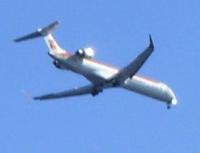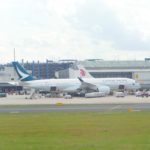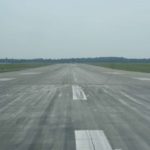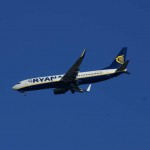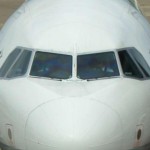Iberia reported its third-quarter results today, which showed a net consolidated loss of 16 million euros. This figure compares unfavourably with that of the same quarter of 2008, when the company posted a gain of 30.4 million euros, but performance was substantially better than that of the first half of the year, when losses amounted to 165 million euros. Losses for the year through September stood at 181.9 million euros.
Madrid – The EBITDAR in the quarter showed a profit of 74 million euros, down by 50% from the figure posted in the same quarter of last year. Operating revenues slipped by another 19%, a rate similar to that of the first two quarters, while costs were reduced by 14.9%, as compared to just 9.6% in the previous two quarters.
Capacity Adjustments Boost Load Factor in Spain and Europe
Iberia’s aircraft seat/kilometre occupancy rate (load factor) stood at 80.0% in the first nine months of the year, down 0.8 points from same-2008, but still higher than the average for the major European network carriers. Total capacity was trimmed by 5.8% to meet market conditions, as demand slumped by 6%.
Aircraft on domestic and European routes were substantially fuller, with load factors up by 2.7 and 2.3 points, respectively, while on long-haul flights, where capacity was left largely intact, the occupancy rate was down 3.2%.
Long-haul flights today account for 63.4% of Iberia’s total seat sales, expressed in RPKs. The Spanish airline has held its position as market leader of Europe-Latin America routes, with a 20.4% share.
Business travel continues to be hard hit by the economic crisis, but Iberia’s long-haul Business Plus class performed slightly better in the third quarter, with a decline of just 9.8%, compared to the 19.7% posted in the first half of the year. Iberia’s market share of business traffic inched a half-point higher in the quarter to 23.8%, enabling the airline to remain in the lead.
Iberia’s air freight traffic has declined at about the same rate as the average for members of the Association of European Airlines, with a decrease of 19.3% in tonne/kilometres (RTK) in the first nine months of the year. But the decline was less steep in the third quarter, amounting to 8.6% in RTK terms, vs. the 24.4% drop posted in the previous two quarters, as markets began to show signs of recovery.
Thanks to the reduction of Iberia’s staff and its aircraft fleet, employee productivity held firm, while fleet capacity use rose by 4.2%.
Traffic Revenues Remain Very Weak
In the first three quarters operating income plunged by 19.1%, due chiefly to the 21.9% fall in air traffic revenues, severely affected by the recession. Airport handling income was off by 4.7% in the first nine months, reflecting the fall in runway activity by customer airlines. However, the third quarter brought an improvement of 0.4% from same-2008. Revenue from aircraft maintenance was little changed in the first three quarters, despite the price cuts occasioned by the weaker market, thanks to a larger load of engine maintenance work and of line maintenance tasks for outside customers. Maintenance income in the quarter was 5.2% below the level posted in same-2008, but this was due mainly to calendar differences, and the figure will rise again in the fourth quarter.
Unit income from passenger traffic, expressed in RPKs, was down by 13.8% in the third quarter, but this was better than the previous quarter, when it fell by 17.1%. Still, it reflected the continuous weakness of the air travel market.
Cost Cuts Deepen
Operating costs in the first nine months of 2009 were 11.4% lower, and the reduction in the third quarter was the largest of all, at 14.9%. the Iberia Group’s unit operating costs dropped by 6.0% in the same period in year-on-year terms, reaching 7.74 eurocents per ASK. Again, the third quarter outperformed the first two, with a savings of 10.6%, vs. the 3.5% of the earlier quarters.
Spending on fuel, which represented 24.3% of total Group operating costs, came to 311.9 million euros less than in the same period of 2008. This was due primarily to the steep decline in prices, but also to the capacity reduction, more efficient use of the fleet, and the favourable impact of euro/dollar exchange rate hedges.
Payroll costs, accounting for 26.6% of operating expenditures, eased by 3.4% with respect to the first nine months of 2008, thanks to across-the board staff cuts amounting to some of some 4.2%, and to wage restraint measures.
Sound Financial Position
On September 30th, the net debt position on the Iberia Group’s balance sheet remained negative, as the balance of financial accounts of current assets (excluding hedge values) was 1,520,8 million euros larger than total debt.
The Iberia Group’s net worth stood at 1,582.5 million euros on September 30th, 2009, 1.2% above the position on at the close of 2008.
In brief:
- Consolidated losses in the third quarter reached 16.4 million euros, vs. earnings of 30.4 million in the same quarter of 2008. However, performance in the quarter was an improvement over that of the previous two
- Operating revenues slipped by 19.6%, in keeping with the trend throughout the year, as passenger traffic continued to decline, and particularly in the business segment
- The load factor reached 82.1%, 1.1 points below its year-ago level, with the sharpest decline on international routes, while passenger cabins on domestic and European flights were significantly fuller than a year ago
- Unit revenues per RPK were down 13.8% from same-2008, and while the decline was less steep than the 17.1% posted in Q-2-2009, it showed continuing demand weakness
- Iberia pursued its capacity adjustment programme, cutting overall seat/kilometre supply by 4.8%. At the same time, staff and fleet reductions held employee productivity at a level similar to last year’s, while fleet capacity use rose by 4.2%
- Unit costs per ASK fell by 14.9%, the sharpest decline in the year to date
- The financial position of the Iberia group remained sound, and its shareholders’ equity on September 30 was up by 1.2% from the end of 2008
- Iberia has held its position as market leader on Europe-Latin America routes, both in total traffic and in business traffic, with a market share of 20.4% and 23.8% respectively.
Picture: Carstino Delmonte/ Touristikpresse.net
